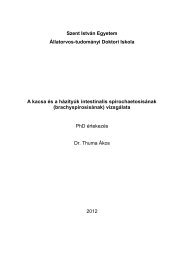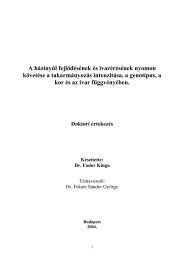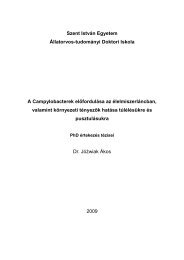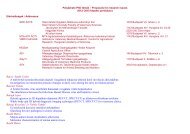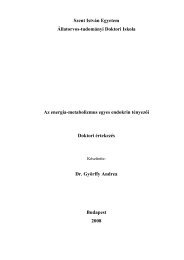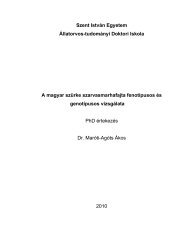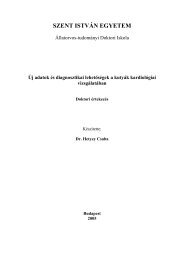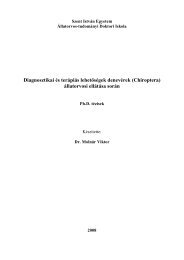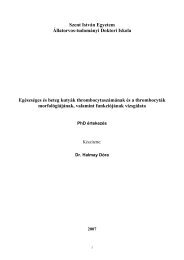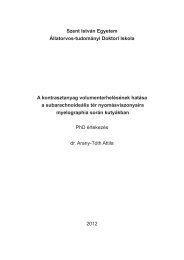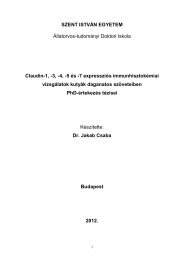Szent István University Postgraduate School of Veterinary Science ...
Szent István University Postgraduate School of Veterinary Science ...
Szent István University Postgraduate School of Veterinary Science ...
Create successful ePaper yourself
Turn your PDF publications into a flip-book with our unique Google optimized e-Paper software.
1. Introduction<br />
In traditional technologies, sheep' dairy products are typically seasonal goods. Due to the<br />
race’s inherent seasonal reproduction activity, their manufacturing is restricted to early<br />
summer. However, great commercial interest is attached to the continuous milk production. In<br />
small ruminants, gestagen+eCG (equine chorionic gonadotropin) treatment is widely used for<br />
cycle induction to get out-<strong>of</strong>-season fertility. Although these protocols are permitted in dairy<br />
flocks, in view <strong>of</strong> the increasing consumer requirements, it is better to refrain from the use <strong>of</strong><br />
sexual steroids in reproduction management <strong>of</strong> milked livestock. An alternative solution for<br />
the future is to try to form flocks, where most <strong>of</strong> the ewes are cyclic during the whole year –<br />
also out <strong>of</strong> the traditional autumn breeding season – allowing fertilization also in spring<br />
besides autumn. Based on researches concerning primarily different merino lines, we know<br />
that the ability <strong>of</strong> perennial cyclicity is genetically determined in sheep, and is in connection<br />
with melatonin receptor 1a (MT1) polymorphism, although the underlying mechanism is not<br />
known in details at the moment (Pelletier et al. 2000, Notter et al. 2003). At the same time<br />
numerous preconditions can influence the manifestation <strong>of</strong> this capacity: such as age, body<br />
condition (BC), and pheromone-exposure. In genotypes which are genetically capable <strong>of</strong> year-<br />
long ovarian cylicity, the use <strong>of</strong> long-known natural or near-natural breeding technologies<br />
(e.g. few days increased energy supplementation; flushing, pheromone exposure by<br />
introduction <strong>of</strong> vasectomized rams to ewes, photoperiodic and/or melatonin treatment) might<br />
gain new dimension, and contribute to clean, green and ethical animal breeding.<br />
The growing demand for clean technologies in animal breeding led to the development <strong>of</strong><br />
novel management tools also in dairy cow. Better understanding <strong>of</strong> the physiology <strong>of</strong><br />
seasonality and the importance <strong>of</strong> the photoperiodic signal in its regulation led to the<br />
emergence <strong>of</strong> technologies which use long-day photoperiodic treatment to increase milk yield<br />
in dairy cow (Dahl et al. 2000). Later the positive link between long-day photoperiodic<br />
treatment and increased milk yield was also proven in goat (Mabjeesh et al. 2007). This drew<br />
our attention to a possible limitation <strong>of</strong> using melatonin implants for cycle induction in sheep.<br />
Treatments acting through the melatonin pathway to induce cycle in the short-day breeder<br />
sheep may negatively influence milk production in lactating dams.<br />
Although seasonality <strong>of</strong> reproductive activity is less expressed in males compared to females<br />
rams also show year-round variation in sexual behaviour, testicular size, and quality <strong>of</strong> semen.<br />
To maximize the out-<strong>of</strong>-season reproductive performance not only ewes but also rams should<br />
be treated accordingly. Administration <strong>of</strong> melatonin in the non-breeding season was shown to<br />
10



